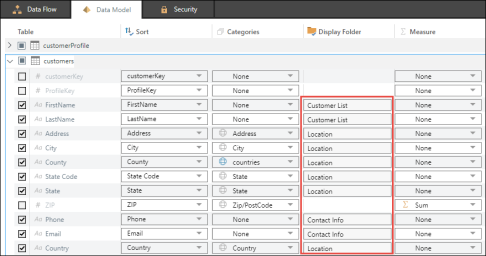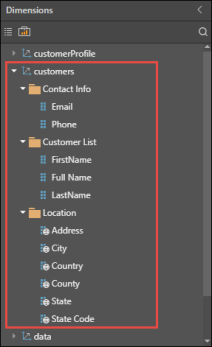Column Configuration
- Assign sorting preferences
- Categorize relevant columns to enable certain functions in Discover
- Assign columns to sub-folders
- Set the aggregation type for measure columns
- Assign measures to measure folders
- Set the formatting for measure columns
Sort
You can sort a column by another column in the same table by selecting an option from the drop-down list. By default, each column is sorted by its own values.
Categories
Relevant columns should be categorized in order to enable various functions later on, such as map visualizations, and date and time calculations. The categories to choose from include date/ time, geospatial, machine learning, and custom map files that have been imported via the Admin console.
To enable geospatial analytics and map visualizations, ensure that geographic columns are assigned the appropriate geospatial category. For instance, the Country category should be assigned to the Country columns. To enable a custom map, assign the relevant custom map file as the category for the relevant geospatial columns.
Date/ time columns should be assigned an appropriate date/ time category to enable time intelligence functionality.
Pyramid will automatically assign the Machine Learning category to any machine learning columns.
Click here to learn more about categories.
Display Folder
This field allows you to set a folder name for the column. In Discover, columns (referred to as hierarchies) are grouped according to the table (known as dimensions) to which they belong.
At this stage of data modeling, users can define additional grouping criteria by placing columns into sub-folders. This can make it easier to navigate large dimensions later on in Discover.
In the example below, the columns in the Customers table could be grouped into Customer List, Location, and Contact Info (red highlight below):

This grouping helps users to easily find the required hierarchies from the Dimensions panel when building data discoveries (red highlight below):

Measures
Pyramid uses heuristics to automatically detect measures and assign an appropriate aggregation type to them. You can change the measure aggregation type, assign measures to text and date/ time columns, assign multiple measures to a column, and more. Click here to learn about configuring measures.
Measure Folders
This is the folder where the corresponding measure will be located in the measures tree in Discover.
Measures not added to a measure folder will be auto-grouped into measure group folders in Discover.
Formats
This indicates the format of the measure. Change the format by selecting one of the drop-down options, or enter a custom format (red arrow below). Formats can be edited by individual users from Discover; this edits the measure overlay for that user only. Admins can also edit measure formats when editing the measure overlay from the Admin console.
![]()
Editing Column Metadata
Individual users can change the categories for selected columns from Discover, as well as the column caption (name). They can also change a measure's caption and format. This is called a hierarchy or measure overlay. When a user applies an overlay from Discover, the overlay will be visible to that user only.
However, Admins can assign hierarchy overlays and measure overlays to specified roles, in order to present hierarchies and measures differently to different user roles. Admins can create overlays consisting of an alternative display folder, description, name, category type (for members), and format string (for measures).